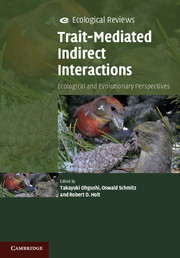Book contents
- Frontmatter
- Contents
- Contributors
- Foreword
- Preface
- Chapter One Introduction
- Part I Community
- Part II Coevolution
- Chapter Eleven Perspective
- Chapter Twelve Evolutionary indirect effects
- CHAPTER Thirteen Indirect evolutionary interactions in a multitrophic system
- Chapter Fourteen The role of trait-mediated indirect interactions for multispecies plant–animal mutualisms
- Chapter Fifteen Consequences of trait evolution in a multispecies system
- Part III Ecosystem
- Part IV Applied Ecology
- Index
- Plate Section
- References
CHAPTER Thirteen - Indirect evolutionary interactions in a multitrophic system
Published online by Cambridge University Press: 05 February 2013
- Frontmatter
- Contents
- Contributors
- Foreword
- Preface
- Chapter One Introduction
- Part I Community
- Part II Coevolution
- Chapter Eleven Perspective
- Chapter Twelve Evolutionary indirect effects
- CHAPTER Thirteen Indirect evolutionary interactions in a multitrophic system
- Chapter Fourteen The role of trait-mediated indirect interactions for multispecies plant–animal mutualisms
- Chapter Fifteen Consequences of trait evolution in a multispecies system
- Part III Ecosystem
- Part IV Applied Ecology
- Index
- Plate Section
- References
Summary
Indirect evolutionary effects
Species interact both directly and indirectly through interactions mediated by a third species. Recently, it has been established that these indirect interactions have important effects on the structure of ecological communities and that they can produce more complex interaction webs than the food webs of direct trophic interactions (Ohgushi 2005, 2007). In this chapter we address the question: can indirectly interacting species separated in space or time influence each other’s evolution? These indirect interactions can evolve if there is a chain reaction where one species exerts selection via a second species on a heritable trait of a third species (Fig. 13.1). If indirect interactions can evolve they may play an important role in community evolution. Measuring indirect interactions is more difficult than measuring direct evolutionary interactions. We will suggest strategies for measuring indirect evolutionary interactions using examples from the community centred on the gall-inducing fly Eurosta solidaginis, its host plants and natural enemies.
Goldenrod–herbivore–natural enemy interaction
Eurosta has formed three partially reproductively isolated populations on Solidago altissima altissima, S. a. gilvocanescens and S. gigantea which we refer to as the forest altissima, prairie altissima and forest gigantea host races, respectively. The forest altissima and forest gigantea host races occur sympatrically in the forest biome of North America (Waring et al. 1990; Craig et al. 1993, 1997, 2001, 2007a, b; Brown et al. 1996; Itami et al. 1998; Stireman et al. 2005; Horner et al. 2008) and the host races on S. altissima gilvocanescens and S. gigantea occur sympatrically in the prairie (Craig et al. 2007a; Craig and Itami 2011). Along the forest–prairie biome border there is geographic mosaic in the distribution of S. a. altissima and S. a. gilvocanescens growing in close proximity to each other.
- Type
- Chapter
- Information
- Trait-Mediated Indirect InteractionsEcological and Evolutionary Perspectives, pp. 244 - 256Publisher: Cambridge University PressPrint publication year: 2012

